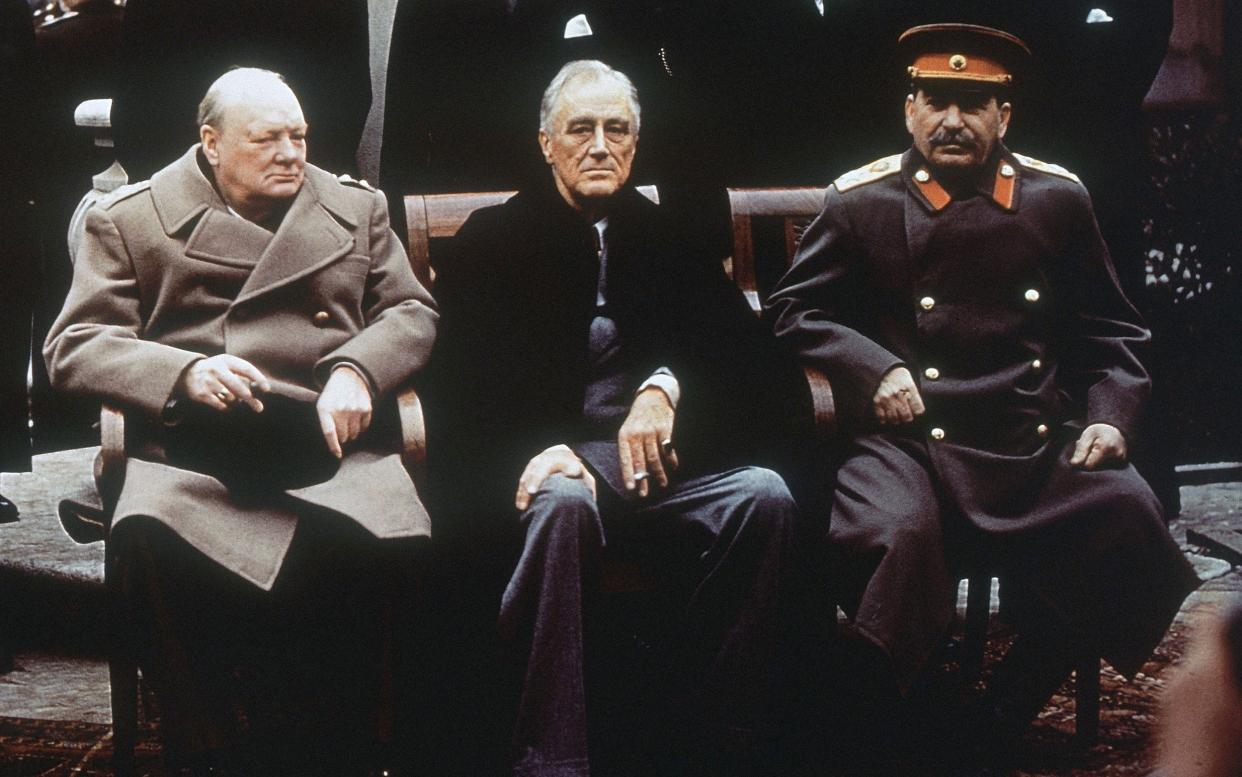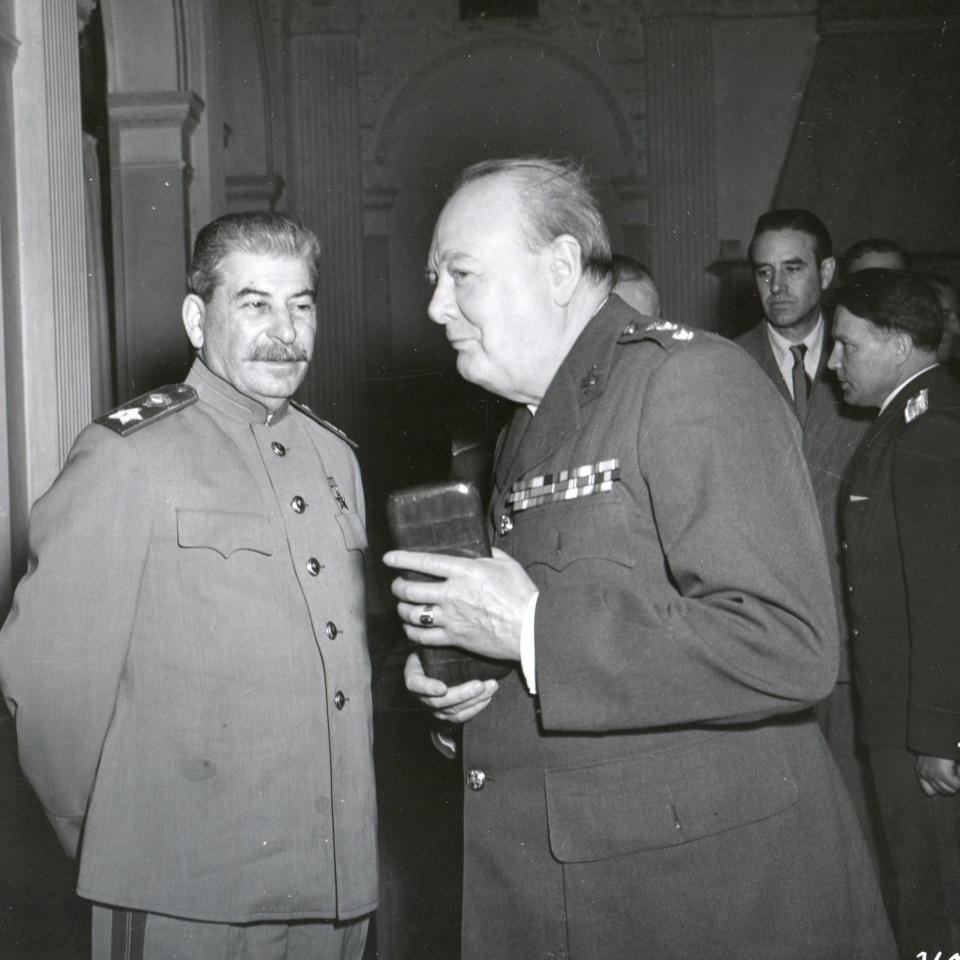Bugged flowerbeds and bathroom lockpicking: what really went on at the Yalta Conference

- Oops!Something went wrong.Please try again later.
In a palace of white Crimean stone surrounded by palms and cypresses, above a beach of black pebbles, sat the Big Three: Winston Churchill, Franklin D Roosevelt, Joseph Stalin, and their entourages. The Yalta Conference was taking place and there with the leaders that February in 1945 were Sarah Churchill, Kathleen (Kathy) Harriman, whose father was Roosevelt’s ambassador to Moscow, and Anna Roosevelt Boettiger, the eldest child of FDR himself.
Kathy Harriman, one of Katz’s three “Daughters of Yalta”, was a bright, friendly 27-year-old with the sort of glossy looks and brimming self-confidence that come from being brought up inside a golden ring of wealth and privilege.
She had grown up in a 100-room mansion; her father, Averell Harriman, was the fourth richest man in America and founder-owner of the Sun Valley ski resort where she was his deputy. The only person in the American suite to speak Russian, she had flung herself with admirable energy into making the dilapidated Livadia Palace fit for its American visitors. The Nazis had stolen everything, from lavatory fittings to brass doorknobs.
Churchill was accompanied by his red-haired, actress daughter, Sarah, 30, a serving WAAF officer then coming to the end of an unhappy marriage. They were put up at the beautiful but equally primitive Vorontsov Palace, a 30-minute drive away. “The setting of our abode was impressive,” wrote Churchill later. “Behind the villa, half Gothic and half Moorish in style, rose the mountains, covered in snow, culminating in the highest peak in the Crimea … Carved white lions guarded the entrance to the house.”
Inside, luxury and squalor fought for precedence: there was only one flush lavatory, dedicated to the prime minister (everyone else, from field marshals downwards, had to use a bucket), yet when Sarah hinted that a slice of lemon might be agreeable with the copious helpings of caviar, a lemon tree appeared overnight.
Roosevelt had brought his only daughter, Anna, the eldest of his five children, a 38-year-old mother of three then living at the White House while her husband served overseas. She looked more like the notoriously plain Eleanor than her father, but as Sarah wrote home, “was so much better looking”. For Roosevelt, confined to a wheelchair, the presence by his side of one of his family was both comforting and helpful, especially so in this case as the president – as only his daughter and his doctors knew – was already dying of congestive heart failure.
There were so many in the American contingent in the Livadia Palace, once the summer retreat of Nicolas II, the last tsar, that 16 colonels had to share one room with extra latrines built in the garden. What the Americans did not realise was the effort that had gone into its bugging; some of the gravel paths had been specially smoothed to make it likely that Roosevelt in his wheelchair would take them and, in the flanking beds, bugs were thickly clustered among the flowers. Nor did they know that one of the most influential of their group, Alger Hiss, was a Soviet spy.

There were already links between the three daughters, of friendship and of shared secrets. Both Kathy and Sarah knew, but did not admit, that Kathy’s father, Averell, and Sarah’s sister-in-law, Pamela, married to Sarah’s brother, Randolph Churchill, were having an affair (many years later, after Pamela had been through a string of lovers, the two would marry). Anna had a secret of her own: she knew and had accepted her father’s mistress, Lucy.
This book, however, is less the story of the three young women of the title, more of a close-focus look at the all-important conference, its political background and its aims and hopes for the coming peace: roughly summed up as collective security and self-determination for the liberated countries of Europe. Katz takes us through it, day by day.
Katz, a Harvard scholar, is admirably impartial, showing us how unprepared Roosevelt was, refusing to be informed about European matters and, as Harriman noted, with “no conception of the Russians’ determination to settle matters in which they consider they have a vital interest … on their own terms”. Nor did Roosevelt care if the countries around Russia fell under communist sway, as this had little effect on American public opinion. He also had the unfortunate conviction that his own charismatic powers could persuade Stalin to do what was best for American interests; as he had told Churchill. “I think I can personally handle Stalin better than either your Foreign Office or my State Department.”
The research is impressive, although the editing could have been fine-tuned; for example, in the Royal Navy it is “HMS Orion”, not “the HMS Orion” and there is some repetition. But it is a riveting read and the detail is fascinating: Harry Hopkins nicking a bottle of whisky from Anna’s suitcase when her back was turned; Churchill’s remark that Molotov had “a smile like a Siberian winter”; Stalin’s photographer, instructed always to photograph him from below to add height to his 5ft 6in; Sir Peter Portal picking the lock of the only bathroom in the British quarters if he thought someone was taking too long and hauling out a dripping field marshal; the Russian idea of an American breakfast: cereal prepared with hot butter and garlic. Oh, to have been a fly on the wall.
Islands of Abandonment is published by William Collins at £25. To order your copy for £19.99 call 0844 871 1514 or visit the Telegraph Bookshop

